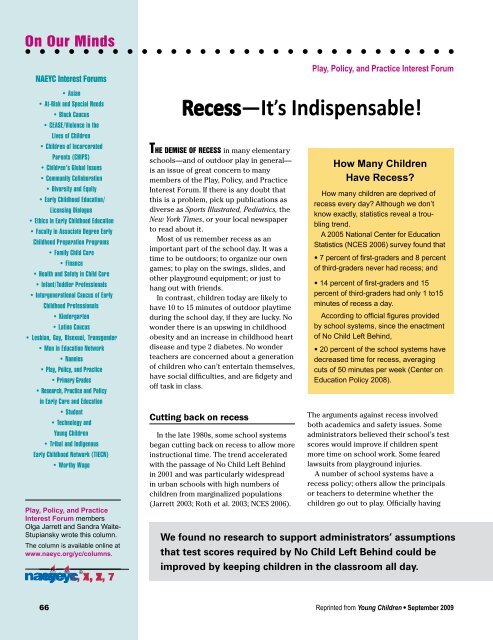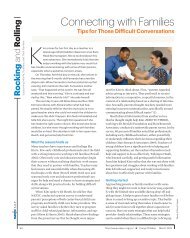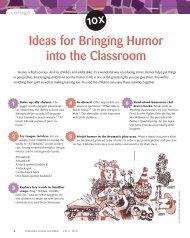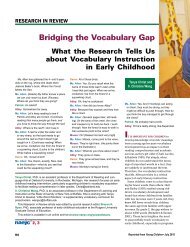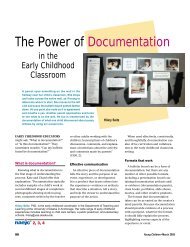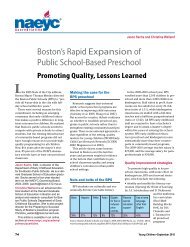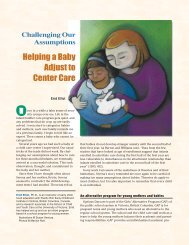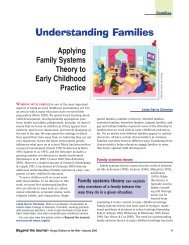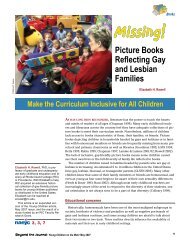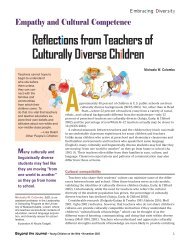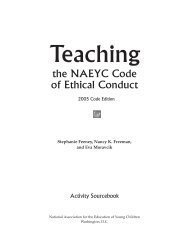Recess—It's Indispensable! - National Association for the Education ...
Recess—It's Indispensable! - National Association for the Education ...
Recess—It's Indispensable! - National Association for the Education ...
You also want an ePaper? Increase the reach of your titles
YUMPU automatically turns print PDFs into web optimized ePapers that Google loves.
On Our Minds<br />
NAEYC Interest Forums<br />
• Asian<br />
• At-Risk and Special Needs<br />
• Black Caucus<br />
• CEASE/Violence in <strong>the</strong><br />
Lives of Children<br />
• Children of Incarcerated<br />
Parents (CHIPS)<br />
• Children’s Global Issues<br />
• Community Collaboration<br />
• Diversity and Equity<br />
• Early Childhood <strong>Education</strong>/<br />
Licensing Dialogue<br />
• Ethics in Early Childhood <strong>Education</strong><br />
• Faculty in Associate Degree Early<br />
Childhood Preparation Programs<br />
• Family Child Care<br />
• Finance<br />
• Health and Safety in Child Care<br />
• Infant/Toddler Professionals<br />
• Intergenerational Caucus of Early<br />
Childhood Professionals<br />
• Kindergarten<br />
• Latino Caucus<br />
• Lesbian, Gay, Bisexual, Transgender<br />
• Men in <strong>Education</strong> Network<br />
• Nannies<br />
• Play, Policy, and Practice<br />
• Primary Grades<br />
• Research, Practice and Policy<br />
in Early Care and <strong>Education</strong><br />
• Student<br />
• Technology and<br />
Young Children<br />
• Tribal and Indigenous<br />
Early Childhood Network (TIECN)<br />
• Worthy Wage<br />
Play, Policy, and Practice<br />
Interest Forum members<br />
Olga Jarrett and Sandra Waite-<br />
Stupiansky wrote this column.<br />
The column is available online at<br />
www.naeyc.org/yc/columns.<br />
®<br />
®<br />
X, X, 1, X2, 7<br />
Play, Policy, and Practice Interest Forum<br />
Recess—It’s <strong>Indispensable</strong>!<br />
The d e m i s e of recess in many elementary<br />
schools—and of outdoor play in general—<br />
is an issue of great concern to many<br />
members of <strong>the</strong> Play, Policy, and Practice<br />
Interest Forum. If <strong>the</strong>re is any doubt that<br />
this is a problem, pick up publications as<br />
diverse as Sports Illustrated, Pediatrics, <strong>the</strong><br />
New York Times, or your local newspaper<br />
to read about it.<br />
Most of us remember recess as an<br />
important part of <strong>the</strong> school day. It was a<br />
time to be outdoors; to organize our own<br />
games; to play on <strong>the</strong> swings, slides, and<br />
o<strong>the</strong>r playground equipment; or just to<br />
hang out with friends.<br />
In contrast, children today are likely to<br />
have 10 to 15 minutes of outdoor playtime<br />
during <strong>the</strong> school day, if <strong>the</strong>y are lucky. No<br />
wonder <strong>the</strong>re is an upswing in childhood<br />
obesity and an increase in childhood heart<br />
disease and type 2 diabetes. No wonder<br />
teachers are concerned about a generation<br />
of children who can’t entertain <strong>the</strong>mselves,<br />
have social difficulties, and are fidgety and<br />
off task in class.<br />
Cutting back on recess<br />
In <strong>the</strong> late 1980s, some school systems<br />
began cutting back on recess to allow more<br />
instructional time. The trend accelerated<br />
with <strong>the</strong> passage of No Child Left Behind<br />
in 2001 and was particularly widespread<br />
in urban schools with high numbers of<br />
children from marginalized populations<br />
(Jarrett 2003; Roth et al. 2003; NCES 2006).<br />
How Many Children<br />
Have Recess?<br />
How many children are deprived of<br />
recess every day? Although we don’t<br />
know exactly, statistics reveal a troubling<br />
trend.<br />
A 2005 <strong>National</strong> Center <strong>for</strong> <strong>Education</strong><br />
Statistics (NCES 2006) survey found that<br />
• 7 percent of first-graders and 8 percent<br />
of third-graders never had recess; and<br />
• 14 percent of first-graders and 15<br />
percent of third-graders had only 1 to15<br />
minutes of recess a day.<br />
According to official figures provided<br />
by school systems, since <strong>the</strong> enactment<br />
of No Child Left Behind,<br />
• 20 percent of <strong>the</strong> school systems have<br />
decreased time <strong>for</strong> recess, averaging<br />
cuts of 50 minutes per week (Center on<br />
<strong>Education</strong> Policy 2008).<br />
The arguments against recess involved<br />
both academics and safety issues. Some<br />
administrators believed <strong>the</strong>ir school’s test<br />
scores would improve if children spent<br />
more time on school work. Some feared<br />
lawsuits from playground injuries.<br />
A number of school systems have a<br />
recess policy; o<strong>the</strong>rs allow <strong>the</strong> principals<br />
or teachers to determine whe<strong>the</strong>r <strong>the</strong><br />
children go out to play. Officially having<br />
We found no research to support administrators’ assumptions<br />
that test scores required by No Child Left Behind could be<br />
improved by keeping children in <strong>the</strong> classroom all day.<br />
66<br />
Reprinted from Young Children • September 2009
ecess and actually having recess are<br />
two different issues. A recent study<br />
in Pediatrics (Barros, Silver, & Stein<br />
2009), using a national data set of<br />
11,000 children, found that 30 percent<br />
of third-graders had fewer than 15<br />
minutes of recess a day. Recess time is<br />
often cut because of academic pressures<br />
or as punishment.<br />
Recess’s many benefits<br />
To make recommendations <strong>for</strong><br />
policy changes, we, as members of<br />
<strong>the</strong> Play, Policy, and Practice Interest<br />
Forum, spent <strong>the</strong> past decade investigating<br />
what research says about<br />
<strong>the</strong> need <strong>for</strong> recess. On <strong>the</strong> one hand,<br />
we found no research to support<br />
administrators’ assumptions that<br />
test scores required by No Child Left<br />
Behind could be improved by keeping<br />
children in <strong>the</strong> classroom all day.<br />
On <strong>the</strong> o<strong>the</strong>r hand, <strong>the</strong>re is considerable<br />
research to suggest that recess<br />
has many benefits <strong>for</strong> children in<br />
<strong>the</strong> cognitive, social-emotional, and<br />
physical domains. Jarrett (2002) gives<br />
a summary of many of <strong>the</strong> research<br />
studies that found <strong>the</strong> following cognitive,<br />
social-emotional, and physical<br />
benefits of recess:<br />
Social-emotional<br />
• On <strong>the</strong> playground, children exercise<br />
leadership, teach games to one<br />
ano<strong>the</strong>r, take turns, and learn to<br />
resolve conflicts.<br />
• In a free choice situation, children<br />
learn negotiation skills in order to<br />
keep <strong>the</strong> play going.<br />
• On supervised playgrounds, particularly<br />
where children are taught games<br />
and conflict resolution skills, <strong>the</strong>re<br />
is little fighting (see “Reconstructing<br />
Recess: One Principal’s Story,” p. 68).<br />
• Intervention programs during recess<br />
can successfully improve social skills.<br />
Physical<br />
• Recess be<strong>for</strong>e ra<strong>the</strong>r than after<br />
lunch leads to healthier eating.<br />
• Children who are active during <strong>the</strong><br />
day are more active after school,<br />
whereas children who are sedentary<br />
during <strong>the</strong> day tend to remain sedentary<br />
after school (couch potato<br />
syndrome).<br />
Children’s activity levels are generally<br />
higher during recess than during<br />
physical education (PE). PE is not<br />
The Demographics<br />
of Recess<br />
A nationwide study on how first<br />
through fifth grade children spend<br />
<strong>the</strong>ir time at school found that on<br />
a randomly selected day, 21% of<br />
children did not have any recess<br />
(Roth et al. 2003). The study noted<br />
demographic disparities:<br />
• 39% of African American students<br />
versus 15% of White students did<br />
not have recess;<br />
• 44% of children living below <strong>the</strong><br />
poverty line versus 17% of those<br />
above <strong>the</strong> poverty line were deprived<br />
of recess; and<br />
• 25% of <strong>the</strong> children scoring below<br />
<strong>the</strong> mean on a standardized test versus<br />
15% of those above <strong>the</strong> mean<br />
did not have recess.<br />
An NCES survey (2006) also found<br />
disparities, with rural schools and<br />
affluent schools more likely to have<br />
recess. A 2003 survey of Georgia<br />
school systems (unpublished data<br />
collected by Jarrett and colleagues)<br />
found <strong>the</strong> same patterns but with 25%<br />
of kindergartners having no recess.<br />
Cognitive<br />
• Children are less fidgety and more<br />
on-task when <strong>the</strong>y have recess, and<br />
children with ADHD (attention deficit/<br />
hyperactivity syndrome) are among<br />
those who benefit most.<br />
• Research on memory and attention<br />
shows that recall is improved when<br />
learning is spaced out ra<strong>the</strong>r than<br />
concentrated. Recess provides breaks<br />
during which <strong>the</strong> brain can “regroup.”<br />
• Brain research shows a relationship<br />
between physical activity and <strong>the</strong><br />
development of brain connections.<br />
• A school system that devoted a<br />
third of <strong>the</strong> day to nonacademic activities<br />
(art, music, physical activity)<br />
improved attitudes and fitness and<br />
slightly increased test scores, in spite<br />
of spending less time on academics.<br />
Photo courtesy of Susan Welteroth<br />
Game Day at Watsontown Elementary<br />
Reprinted from Young Children • September 2009<br />
67
seen by <strong>the</strong> PE teachers or <strong>the</strong> children<br />
as a substitute <strong>for</strong> recess. Recess<br />
and PE serve different purposes.<br />
Research also suggests benefits <strong>for</strong><br />
teachers, even when <strong>the</strong> teacher is<br />
required to supervise on <strong>the</strong> playground.<br />
Recess can help with classroom<br />
management:<br />
• Teachers rated children’s behavior<br />
as better in classes where children<br />
had at least 15 minutes of recess<br />
(Barros, Silver, & Stein 2009).<br />
Reconstructing Recess: One Principal’s Story<br />
At Watsontown Elementary in central Pennsylvania, a small K–4 school<br />
where I am principal, <strong>the</strong> staff and I noticed conflicts, exclusion, and safety<br />
concerns on <strong>the</strong> playground during recess. We felt strongly that we needed to<br />
turn recess around.<br />
We talked extensively and agreed that recess should be respectful, have<br />
safe play, include child choice, and encourage all children to participate. We<br />
also discussed <strong>the</strong> teachers’ role at recess. We committed to simple, consistent<br />
rules—respect <strong>for</strong> self, o<strong>the</strong>rs, <strong>the</strong> play environment, and <strong>the</strong> play equipment.<br />
Teachers brainstormed games that encourage responsibility, cooperation, and<br />
communication and made a list of <strong>the</strong> games to facilitate child choice.<br />
We decided that be<strong>for</strong>e recess, children would choose from <strong>the</strong> list of cooperative<br />
games or old standbys (jump rope, hopscotch, four square). Children<br />
could also choose not to participate and instead play on <strong>the</strong>ir own. Teachers<br />
would review <strong>the</strong> rules and acceptable behaviors <strong>for</strong> <strong>the</strong> games be<strong>for</strong>e going to<br />
<strong>the</strong> playground (“What does it look like to tag someone?”).<br />
With <strong>the</strong> start of <strong>the</strong> new school year, we designated <strong>the</strong> second day Game<br />
Day <strong>for</strong> <strong>the</strong> staff to demonstrate <strong>the</strong> games, modeling <strong>the</strong> behaviors we wanted<br />
<strong>the</strong> children to use and allowing <strong>the</strong>m to practice <strong>the</strong> skills in a safe environment.<br />
In a reflective writing activity at <strong>the</strong> end of Game Day, most children and<br />
teachers wrote about prosocial skills—inclusion, fair play, and teamwork.<br />
Throughout <strong>the</strong> school year, teachers rein<strong>for</strong>ced <strong>the</strong> concepts learned on<br />
Game Day. They helped children problem solve issues like what to do when<br />
teams had unequal skill levels and what happens if a child wants to jump rope<br />
but all <strong>the</strong> jump ropes are in use. Game Day didn’t magically eliminate all of<br />
<strong>the</strong> playground concerns, but we now heard students supporting each o<strong>the</strong>r<br />
during recess.<br />
Interested in reconstructing recess in your school? Here are some thoughts<br />
<strong>for</strong> teachers and administrators:<br />
• Schedule recess every day <strong>for</strong> primary and elementary level children. Breaks<br />
from academics are important, and children need opportunities to practice<br />
positive social interactions.<br />
• Agree on basic rules that apply throughout <strong>the</strong> school building and <strong>the</strong> day.<br />
• Build a repertoire of games that encourage cooperation and responsibility<br />
and avoid conflicts.<br />
• Teach <strong>the</strong> games using modeling and practice. Rein<strong>for</strong>ce children’s prosocial<br />
skills throughout <strong>the</strong> school year.<br />
• Provide enough materials and equipment <strong>for</strong> several groups of children to<br />
play <strong>the</strong> same game. Help students make choices about which games to play.<br />
• Provide teacher supervision during recess, and encourage <strong>the</strong> children<br />
during play.<br />
— Susan Welteroth (swelteroth@wrsd.org)<br />
• Teachers get to know <strong>the</strong> children<br />
better when supervising <strong>the</strong>m on <strong>the</strong><br />
playground. This knowledge can be<br />
useful in developing curriculum and in<br />
preventing bullying.<br />
• Time on <strong>the</strong> playground is a change<br />
of pace <strong>for</strong> <strong>the</strong> teacher as well as <strong>for</strong><br />
<strong>the</strong> children.<br />
Children’s right to play<br />
We believe that recess is a right,<br />
not a privilege. Article 31 of <strong>the</strong> U.N.<br />
Convention on <strong>the</strong> Rights of <strong>the</strong> Child<br />
(www.unicef.org/crc) recognizes<br />
The right of <strong>the</strong> child to rest and<br />
leisure, to engage in play and recreational<br />
activities appropriate to <strong>the</strong><br />
age of <strong>the</strong> child and to participate<br />
freely in cultural life and <strong>the</strong> arts.<br />
We believe that recess, with its fun,<br />
movement, and opportunities to<br />
socialize through play, is a basic<br />
need and that policies against recess,<br />
whe<strong>the</strong>r made at <strong>the</strong> school system,<br />
school, or teacher level, discriminate<br />
against children. Depriving a child<br />
of recess as punishment is similar<br />
to depriving a child of lunch. It is<br />
not only unfair, it is also unhelpful.<br />
Just as hungry children cannot concentrate<br />
well, children deprived of<br />
breaks cannot concentrate well ei<strong>the</strong>r.<br />
Sometimes <strong>the</strong> most disruptive children<br />
need recess <strong>the</strong> most.<br />
Stand up <strong>for</strong> recess!<br />
What can you do? Here are some<br />
steps you can take:<br />
• Find out whe<strong>the</strong>r <strong>the</strong> schools in your<br />
community have recess, and if so, <strong>for</strong><br />
how many minutes a day. Do all <strong>the</strong><br />
children get recess?<br />
• Check school playgrounds <strong>for</strong> safety.<br />
The <strong>National</strong> Program <strong>for</strong> Playground<br />
Safety (NPPS) has helpful online resources<br />
(www.playgroundsafety.org).<br />
Examine <strong>the</strong> needs <strong>for</strong> supervision.<br />
Generally, teachers supervise recess;<br />
but in some cases, o<strong>the</strong>r supervisors<br />
are hired.<br />
68 Reprinted from Young Children • September 2009
Advocacy can take<br />
many <strong>for</strong>ms, including<br />
writing letters to<br />
<strong>the</strong> school board and<br />
newspaper, circulating<br />
petitions, and organizing<br />
rallies.<br />
• Knowledge is power. Stay in<strong>for</strong>med<br />
about what research says about<br />
recess. The references at <strong>the</strong> end<br />
of this article should be helpful.<br />
Also check www.ipausa.org, <strong>the</strong><br />
Web site of <strong>the</strong> American Affiliate of<br />
<strong>the</strong> International Play <strong>Association</strong>,<br />
Promoting <strong>the</strong> Child’s Right to Play.<br />
• Organize. Most changes occur<br />
because people work toge<strong>the</strong>r.<br />
Teachers and families often make<br />
great recess advocates. So do students.<br />
Children can collect data, write<br />
letters, and make posters. In some<br />
schools, <strong>the</strong> ef<strong>for</strong>ts of children have<br />
gotten recess reinstated.<br />
• Meet with principals, <strong>the</strong> school<br />
superintendent, and legislators and<br />
elected officials. Share your knowledge,<br />
but also be a good listener. Listening<br />
helps you learn more about <strong>the</strong> issues<br />
and also builds mutual respect.<br />
• If friendly persuasion fails, advocacy<br />
can take many <strong>for</strong>ms, including writing<br />
letters to <strong>the</strong> school board, writing letters<br />
to <strong>the</strong> newspaper, circulating petitions,<br />
and organizing rallies. Advocates<br />
in several states have even introduced<br />
legislation to ensure that children<br />
statewide are guaranteed recess.<br />
References<br />
Barros, R.M., E.J. Silver, & R.E.K. Stein. 2009.<br />
School recess and group classroom behavior.<br />
Pediatrics 123 (2): 431–36.<br />
Center on <strong>Education</strong> Policy. 2008. Instructional<br />
time in elementary schools: A closer<br />
look at changes <strong>for</strong> specific subjects. www.<br />
cep-dc.org/_data/in_0001/resources/live/<br />
InstructionalTimeFeb2008.pdf<br />
Jarrett. O.S. 2002. Recess in elementary<br />
school: What does <strong>the</strong> research say? ERIC<br />
Digest. ED 466331 2002-07-00. www.eric<br />
digests.org/2003-2/recess.html<br />
Jarrett, O.S. 2003. Urban school recess: The<br />
haves and <strong>the</strong> have nots. Play, Policy & Practice<br />
Connections 8 (1): 1–3, 7–10.<br />
NCES (<strong>National</strong> Center <strong>for</strong> <strong>Education</strong> Statistics).<br />
2006. Calories in, calories out: Food<br />
and exercise in public elementary schools,<br />
2005. Table 12. http://nces.ed.gov/Pubs2006/<br />
nutrition/tables/tab12.asp. Table 13. http://<br />
nces.ed.gov/Pubs2006/nutrition/tables/<br />
tab13.asp<br />
Roth, J., J. Brooks-Gunn, M. Linver, & S.<br />
Hofferth. 2003. What happens during <strong>the</strong><br />
school day? Time diaries from a national<br />
sample of elementary school teachers.<br />
Teachers College Record 105 (3): 317–43.<br />
Recommended Reading<br />
Clements, R.L., ed. 2000. Elementary school<br />
recess: Selected readings, games, and<br />
activities <strong>for</strong> teachers and parents. Boston:<br />
American Press.<br />
Pellegrini, A.D. 2005. Recess: Its role in education<br />
and development. Mahwah, NJ: Erlbaum.<br />
Copyright © 2009 by <strong>the</strong> <strong>National</strong> <strong>Association</strong> <strong>for</strong> <strong>the</strong> <strong>Education</strong><br />
of Young Children. See Permissions and Reprints online at<br />
www.naeyc.org/yc/permissions.<br />
Teacher Enrichment Training Solutions<br />
ChildCare <strong>Education</strong> Institute (CCEI), a distance training institution,<br />
is dedicated to providing online training to meet <strong>the</strong> continuing<br />
education requirements of <strong>the</strong> child care industry.<br />
CCEI Offers Early Childhood Professionals:<br />
• Online, User-Friendly Professional Development<br />
• Self-Paced Format and Web-Based Access 24/7<br />
• Over 100 Courses in English & Spanish<br />
• IACET CEUs Awarded <strong>for</strong> Completed Coursework<br />
• Coursework That Articulates to College Credit<br />
• CDA Coursework Including College Credit Eligible CDA & CDA Renewal<br />
• <strong>National</strong> Administrator’s Credential (NAC) & NAC Renewal<br />
Visit CCEI online at www.cceionline.com<br />
or call Admissions at 888.418.5358<br />
© 2009 ChildCare <strong>Education</strong> Institute, 3059 Peachtree Industrial Blvd., Duluth, GA 30097. All rights reserved.


